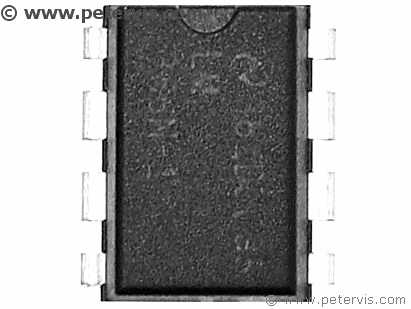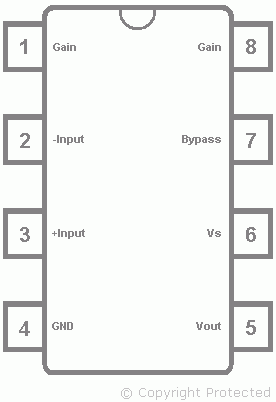LM386 Audio Amplifier

The LM386 is a low voltage audio amplifier IC manufactured by National Semiconductor. There are three versions of this IC, LM386N-1, LM386N-3, LM386N-4, capable of providing power output of 0.125 W, 0.8 W, and 1 W respectively. All the versions are available in dual in-line package (DIP), which is useful for hobby amplifier projects; however, the LM386M-1 version is available in SO package, and the LM386MM-1 version is available in mini small outline package. The LM386 is a mono amplifier IC with a default fixed gain of 20, and may be set to 200 (gain = 200) after the addition of a 10 µF capacitor between pin 1 and pin 8. The main advantage of this IC is its bass boost function with the addition of only two external components.
If you are constructing this circuit on breadboard, then it is better to keep all the wires short, otherwise, increasing the gain to 200 can introduce feedback noise. Alternatively, it is much cheaper to buy a readymade module online for 99p and it works far better due to short tracks and SMD components.
Gain = 200
This chip has fixed gain of 20 without requiring additional components;however, it increases to 200 with the addition of a 10 µF capacitor across pin 1 and pin 8. These pins are part of the feedback loop, and internally there is a 1.35 kΩ resistor connecting them. By connecting an external resistor and capacitor in series across these pins, any gain between 20 and 200 is set.
Circuit with Bass Boost
A lesser-known fact about this chip is that it has frequency shaping capability. This mode is enabled using a single component and provides a nice bass sound. This is very useful if you are using a small cheap speaker and require it to produce more bass. For the bass boost function, you simply need a series RC between pin 1 and pin 5. A capacitor of 0.033 µF in series with a 10 kΩ resistor would work well.
IC Pinout

The beauty of this chip is that it requires very few external components, which makes it ideal in applications where space is an issue. For students and hobbyist the PDIP version works well with breadboard layouts.
LM386 Pin 7 Bypass
This pin is for optional use, and for the most part in the documentation, the recommendation is that you leave it unconnected if you wish to build an amplifier with low gain and minimum components.
On the National Semiconductor version, if the gain is 20, then you may not require a decoupling capacitor from pin 7 to ground. However, with a gain of 200 decoupling may be required. It may also be required for amplifier circuits with a gain of 50, oscillator circuits, and bass boost circuit. For power amplifier circuits, up to 10 µF is used in their example.
On the full datasheet of NJM386B, by New Japan Radio Co Ltd, Pin 7 (bypass) provides an additional muting function through a switch. A switch connected between pin 7 and ground, or a switch connected between pin 7 and the positive rail usually causes the IC to mute the output, however, this is very much an optional facility.
Speaker Power Output
- LM386N-1
- Vs = 6 V
- Rl = 8 Ω
- Pout = 0.125 W
- LM386N-3
- Vs = 9 V
- Rl = 8 Ω
- Pout = 0.700 W
- LM386N-4
- Vs = 16 V
- Rl = 32 Ω
- Pout = 1 W
With this IC, you can achieve a maximum of 1-watt output by using a single LM386N-4 IC with a power source of 16 V and speaker coil of 32 Ω. This is very loud if you were to use it to drive a pair of headphones or a small speaker.
Low Voltage Applications
LM386N-1 and LM386N-3 will operate on a minimum voltage of 4 V, whilst the LM386N-4 requires 5 V, making them ideal for portable applications. Typically, one would use four AA size batteries providing 6-volts, or a single 9 V (PP3) battery, depending upon the design application.
Where to Buy
The current rate was approximately ten chips for a few pounds on eBay. They always seem to have some good offers.
